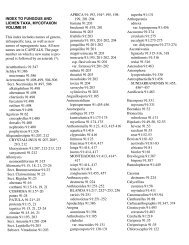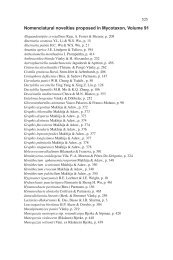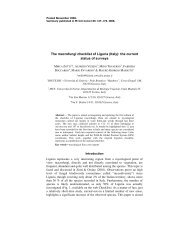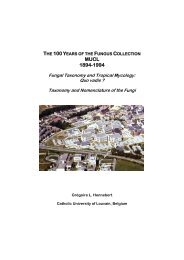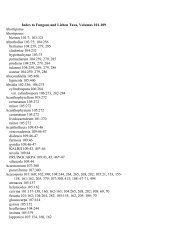download full review [pdf] - Mycotaxon
download full review [pdf] - Mycotaxon
download full review [pdf] - Mycotaxon
You also want an ePaper? Increase the reach of your titles
YUMPU automatically turns print PDFs into web optimized ePapers that Google loves.
550 ... Hawksworth, Editor<br />
Lichen flora of the Greater Sonoran Desert Region. Vol. 3. Edited by Thomas<br />
H. Nash III, Corinna Gries & Frank Bungartz. 2007. Lichens Unlimited, Arizona<br />
State University, Box 874501, Tempe, AZ 85287-4501, USA. Pp. viii + 567, figs 36, col.<br />
plates 56, maps. ISBN 0-9716759-1-0. Price US $ 49.95, 43 €.<br />
This volume completes this stupendous work, the first volume of which appeared<br />
in 2002 (see <strong>Mycotaxon</strong> 86: 485-486, 2003) and the second in 2004 (see<br />
<strong>Mycotaxon</strong> 96: 350-351, 2006). Again it is very much a result of a productive<br />
international co-operation and has involved 47 authors from 15 countries. It<br />
covers the “balance of the microlichens, and the lichenicolous fungi” – actually<br />
38 lichenized genera and four of lichenicolous fungi. In addition, there is further<br />
information on 16 genera covered in the previous volumes where further<br />
species have subsequently been discovered. This volume is especially valuable<br />
as it includes the treatments of some taxonomically difficult and speciose<br />
genera in some of which new species to science have also been discovered: for<br />
example, Acarospora with eight new species, Aspicilia with 19, Buellia with two,<br />
Caloplaca, Opegrapha with three, Usnea with three, and Verrucaria with seven.<br />
There are also numerous new combinations and even a new genus, Romjularia<br />
in Porpidiaceae for the species previously widely known as Psora lurida. In<br />
addition to a few half-tone photographs scattered through the volume, there is<br />
a signature of 56 un-numbered pages comprising excellent colour photographs<br />
of over 220 species – many more than in the previous volumes. These colour<br />
photographs are mainly of species treated in this volume but also include some<br />
not figured in colour in the previous two.<br />
The overall layout naturally follows that of the previous volumes, and brings<br />
the total number of species covered in the three volumes to 1971, of which 1836<br />
are lichenized – about 40 % of all the species known throughout the whole of<br />
North America. This last volume also has some special features: a key to sterile<br />
crustose lichens, a revised key to the cyanobacterial lichens, and a critical<br />
revision of the lichens reported from southern California in the classic treatise<br />
by Hasse published in 1913. There is also a cumulative index covering all three<br />
volumes, a compilation of the new scientific names introduced (which include<br />
186 new species), and an index to where the major keys are found.<br />
Of course there are the odd spelling slips, such as “Sktyella” for “Skytella”<br />
(p. 297), and other minutiae a persnickety <strong>review</strong>er might point out, but these<br />
hardly distract from what is essentially a meticulously and superbly edited<br />
work. That Tom Nash has been able to exert such editorial dragooning to<br />
achieve accounts of such a consistently high standard cannot but be admired.<br />
And to realize his vision with a product that bears such a modest price! It sets<br />
a new standard for regional works on lichens, covering as it does the <strong>full</strong> range<br />
of lichens and lichenicolous fungi in this vast region. Further, as so many of<br />
species treated occur elsewhere, not only in North America but the Northern<br />
Hemisphere, this trio of volumes is surely something all lichenologists will both


![download full review [pdf] - Mycotaxon](https://img.yumpu.com/5381692/42/500x640/download-full-review-pdf-mycotaxon.jpg)
